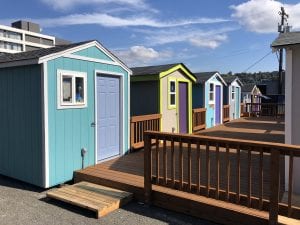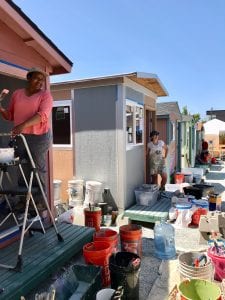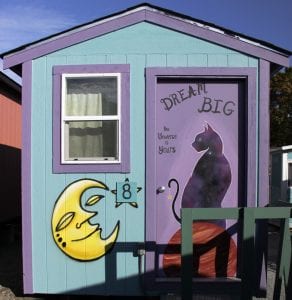
Six tiny houses share a common deck in Lake Union Village. Photo courtesy of LIHI.
In 2017, I wrote a piece for Shelterforce on Seattle’s then-emerging effort to build tiny houses to shelter homeless families, couples, and singles. Over the past three years, Seattle has led the country in piloting this response to the homelessness crisis. There are now 10 tiny house villages located throughout Seattle on government, private, nonprofit, and church-owned properties.
The villages are sponsored by the Low Income Housing Institute (LIHI), where I am executive director, and nine tiny house villages receive financial support from the City of Seattle.
We’ve come to see that tiny house villages are an effective crisis response to homelessness, and have proven to be a rapid, cost-effective response with better outcomes than traditional shelters.
Quick Set Up
Seattle’s mayor and city council have been tasked with addressing the needs of unsheltered homeless people. Last January, the Seattle/King County Point-In-Time Count tallied 12,112 homeless men, women, and children, with over half of them living in unsheltered situations. The unsheltered population in the city of Seattle makes up 71 percent of the county total.
When Mayor Jenny Durkan took office in January 2018, she authorized the first tiny house village exclusively for homeless women. The Whittier Heights Village is located on property owned by Seattle public utility City Light and shelters single women, same-sex couples, seniors, pregnant women, and women with pets. The mayor also funded two additional villages: True Hope Village, which is church-sponsored and focuses on people of color including families with children; and Lake Union Village (LUV), for singles and couples, located on a city-owned parking lot. All three villages were planned, constructed, and opened in 2018, and together shelter 155 homeless people.
How did this happen so quickly? The mayor prioritized the need. She’d campaigned on the need for 1,000 tiny houses, and once in office, directed her staff in the Department of Finance and Administrative Services (FAS) to compile an inventory and identify vacant city-owned sites, including those owned by city utilities that could be prepared quickly for the villages.
A village requires anywhere from 6,000 to 30,000 square feet of vacant land, depending on the number of tiny houses and common facilities to be placed there. There are suitable urban infill sites zoned for residential and mixed use, as well as larger commercial and industrial sites. It takes careful research and help from local government to identify good sites, and we were quite surprised to find a large inventory of publicly owned underutilized and surplus sites held by the city, county, state and even the Port of Seattle. We also found multiple nonprofit, private, and church-owned properties that could be used. Nonprofit housing organizations own land that they hope to develop in the future, and these can be used on an interim basis, from two to four years, for a tiny house village.
Each village needed only four to six months’ lead time to be constructed. Staff at FAS partnered with our organization, the Low Income Housing Institute, and coordinated with other city departments to bring in water, sewer, and electrical connections to the sites. There are 15 to 34 tiny houses at each village, plus shared community kitchens, community meeting space, counseling offices, storage, donation huts, security huts, and plumbed bathrooms, showers, and laundry facilities.

A volunteer paint party at True Hope Village. Photo courtesy of LIHI.
An effective partnership between multiple departments in the city and LIHI was key in setting up the villages. Staff at LIHI worked closely with the city and our architects to plan each village. LIHI staff led the effort to raise funds to construct the tiny houses, reaching out to hundreds of donors and volunteers. We applied for permits, led work parties to build the houses, and developed the management and staffing plans. We undertook extensive community outreach to neighbors, businesses, and the public, working alongside city staff, including the Seattle Police Department and the Human Services Department, which funds LIHI for operations and services. While not everyone was supportive, they were all provided detailed information on the management plan and code of conduct, and were invited to submit their names to serve on a community advisory committee. Each village, staffed 24/7, has Village Organizers and dedicated case managers to assist people in obtaining long-term housing, employment and services.
Tiny House Villages vs. Other Options
Unlike developing and building a new emergency shelter—which could take many years for siting, permitting, and construction, plus millions of dollars in construction costs—creating a tiny house village can be done in less than six months and costs between $100,000 and $500,000. (A large variable is the cost of connections for water, sewer and electricity.) Each village can serve 20 to 70 people on an annual budget of $60,000 to $500,000, depending on staffing and services. We also partner with homeless resident organizations to operate six self-managed villages where residents are organized to manage day-to-day operations and employ democratic decision-making. This model reduces overall operating costs.
The Seattle Human Services Department has documented the village’s cost effectiveness: “Spaces in tiny home villages represent approximately 12.5% of all shelter beds and safe places the City supports and make up less than 3% of all homelessness response investments made by the City of Seattle.”
Among other local options to shelter homeless people, many are more expensive and take more time to set up than a tiny house village. The City of Bellevue’s effort to identify a site for a new shelter for single men has taken six years because of community opposition. Financing, permitting and construction will take another two years, for a total of eight years before the shelter might open. King County just announced a plan to open and renovate an unused portion of the county’s jail to shelter 100 people. It is budgeted to cost $2 million to convert the space plus $4 million to fund the next two years of operations. Concerns include not only the optics of putting homeless people in a jail facility, but the cost per person is more than double that of a tiny house village.
Compared with other options, tiny house villages have presented a quicker, more humane, and cost-effective solution.
What About Shelters or Tents?
According to Seattle Police Sgt. Eric Zerr of the city’s Navigation Team, tiny houses are the preferred option for people who are removed from the street by law enforcement, as well as those living in RVs and cars. In situations of forced removal, people will gather their tents and belongings and relocate to another neighborhood, or move away and then return to the same spot after a short time rather than enter a shelter.
Due to the sheer number of homeless people and the city’s inability to meet that need, Seattle’s shelters are often full. Men and women are usually sheltered separately, meaning couples, teenaged sons, and pets are often turned away. Many homeless people who are camping on the street or under bridges will refuse to move into a shelter, but will agree to move into a tiny house.
“Tiny house villages play a crucial role in helping the City move unsheltered people from dangerous conditions on the streets and into a more safe and supportive environment… and on a path to stable housing,” states the Seattle Human Services Department.

A tiny house at True Hope Village. Photo courtesy of LIHI.
Living in a tiny house is much more comfortable and healthy than trying to survive in a sleeping bag or a cold, wet tent. Each tiny house is 8 by 12 feet, the size of a small bedroom, and is insulated and heated. A small family can live in a tiny house, and a large family can live in two tiny houses side by side. Each furnished house has a locking door, windows, electric light, electrical outlet, and smoke detector.
Hundreds of dedicated students, volunteers, churches, and businesses have built and donated over 325 tiny houses at an average cost of $2,500 each for construction materials. Volunteers make the houses comfortable and home-like by adding flower boxes, porches, curtains, artwork, and furniture. The tiny house built by a local Girl Scout troop included a bed, comforter, dresser, rug, art, and even boxes of cookies. Last year at Seattle’s CenturyLink Event Center, over 400 Vulcan employee volunteers, along with pre-apprentices and contractors led by Associated General Contractors of Washington, built 30 tiny houses in one day.
Tiny houses are changing people’s lives for the better. People living in a tiny house can keep themselves, their family, and belongings safely indoors and not worry about frequent moves between shelters. Having a secure place to live day and night, with access to showers, laundry, and a kitchen enables homeless people to find work, maintain a job, attend school, improve their health, and access services.
The average length of stay in a tiny home village is four to five months, and there is no time limit. An important factor has been people’s engagement with case managers in order to get “housing ready” with proper ID, Social Security cards, completed housing applications, and steadier income support or employment. A number of the villages are now requiring that residents agree to meet with the case manager, as this increases the likelihood that they will obtain permanent housing.
According to the King County Medical Examiner, 191 homeless men and women died in 2018 from exposure, chronic health conditions, violence, accidents, and suicide. The stability of tiny houses helps to alleviate these conditions.
Successful Outcomes
An important feature in the operation of the villages is the presence of dedicated case managers and social workers who link residents to services. The rate of successful housing placements in 2017 was 39 percent. LIHI worked closely with the Human Services department to bring more case management capacity to the villages in 2018, which is paying off.
During 2018, the villages served 879 homeless men, women, and children. Of the 491 who exited the villages, a total of 166 people, or 34 percent, were successful in obtaining permanent housing. If we include the additional 42 individuals who moved into transitional housing (receiving up to two years of Section 8 subsidies and help in moving to permanent housing), the percentage who obtained housing is 42 percent. In comparison, data provided by the Seattle Human Service Department (third quarter 2018) shows the rate of exits to permanent housing from city-funded shelters at only 4 percent, and enhanced around-the-clock shelters at 20 percent.
What We Have Learned
Tiny houses are a bridge to permanent housing. Our case managers have been very successful in finding subsidized housing, permanent supportive housing, and private housing for families and individuals who engage with them.
But what about those who refuse to cooperate or meet with our case managers? At the start of the program, a “low barrier” or housing-first approach was employed, where it was optional to meet with the case manager. Some people ended up living in a tiny house for over a year, refusing to obtain identification, get a Social Security card, or sign up for public assistance, Social Security, VA benefits, or TANF. The newer villages now require that people meet with a case manager to get on a path to secure housing.
Having people live long-term in a tiny house is not our goal, and so we quickly found out that it made sense to clearly define the target population for each village. In Seattle, we offer villages for women only, three for single adults and couples, five for a mix of families with children, and singles. Three villages are operated on a harm reduction, low-barrier model, and seven prohibit alcohol and drugs in or around the villages.
The Human Services Department completed an evaluation of the effectiveness of tiny house villages and said, “The City-permitted encampments have met and exceeded the contracted performance measure. The model is successfully serving people who have been living outside in greenbelts, on the streets, in cars and in hazardous situations.”
Our 11th village, Plum Street Village, opened in February 2019 in the city of Olympia on city-owned land. It will serve 40-45 people referred through Coordinated Entry. The Olympia City Council agreed to fund Plum Street Village and the City issued a challenge to local faith-based organizations to establish tiny houses on their property. Three churches and temples are participating, and will receive funding from the city. LIHI will help establish the three new villages and will provide case management support.
We believe that LIHI’s successful partnership with the City of Seattle to provide its homeless residents shelter in tiny houses can translate well to other municipalities that lack sufficient affordable housing and shelters. We invite homeless service providers, housing nonprofits and local government officials to come to Seattle and visit these villages.
For more information on Tiny House Villages visit: LIHI.org or www.seattle.gov/homelessness/city-permitted-villages.
For a different perspective on Tiny Homes, see Tiny Homes—Not a Big Enough Solution.






Frank Beifus it should be no secret by this time. study’s have been done that prove housing a homeless person is actually cheaper then putting them into a shelter system. and tiny houses are even cheaper. plus they are a step closer to home ownership. a huge step for some one beaten down by circumstances and the system. it could restore there dignity and make them more productive. at the very least less of a threat or eyesore to the public.
It will be interesting to see, in a year or two, how much these tiny houses really cost. What is NOT being figured in here is the cost of maintenance to the homes themselves, and the cost of pest control. (if these homes get bed bugs, they’ll need to be demolished) These tiny structures require CONSTANT attention and un-addressed moisture issues will quickly affect quality of life. I will admit I am not a huge fan of these “tiny houses” being use as homeless structures mainly because they’re NOT houses, they’re bedrooms. But “tiny bedrooms” don’t garner the same social media attention that the term “tiny houses “does. Secondly, I live in a tiny house (by choice, not necessity) and do not appreciate the stigma and the “social depreciation” of my asset that is made by people who assume they are ONLY a viable living solution for the homeless. I am optimistic that a better homeless solution can be found but I’m not convinced that we’re there yet. Anyone who’s worked in the low income housing industry KNOWS that low entrance barriers always cause issues with housing. Why would you open a village without criteria for its inhabitants? That’s plainly unsafe and irresponsible. On the flip side, tiny homes do force the discussions around affordable housing so that’s definitely a good thing for all of us who hope they’ll officially be legal to occupy eventually. And by “they” I mean tiny homes with bathrooms, and bedrooms, and kitchens, and responsible full time occupants.
“Secondly, I live in a tiny house (by choice, not necessity) and do not appreciate the stigma and the “social depreciation” of my asset that is made by people who assume they are ONLY a viable living solution for the homeless.”
Wow. Okay.
Ditto
So in other words you don’t like tiny house villages because you bought a real tiny home first and it’s wayyyy nicer than those “tiny bedrooms” the homeless stay in. And you’re a real person with a real job, not an irresponsible homeless person. So really it’s about others’ perception of you.
“Why would you open a village without criteria for its inhabitants?”
Because denying people is going to keep them homeless. It’s really that simple.
I think it’s a wonderfulthing. Its 100% better than being homeless. Thank God for the people providing these Veterans with the opportunity for a new home to live in. Take 1 day at a time
There are thousands of tiny homes that are really homes and cost far less than these boxes. They are called vacation trailers. I lived in an older one I was in the final year of university that was 18′ long and was fully self-contained. These could be purchased, rented or whatever, from individuals who have older, but attractive vacation trailers. Even if the toilet would not be able to be hooked up to sewer, it is quite easy to have them hooked up to water and electricity.
Why not do this? Perhaps even allow some to be parked in some private driveways and hooked into their sewers (yes, it would nto meet current code) but really, do tiny homes?
I WISH TO HAVE A SOMETHING LIKE IT IM WANT TO START MY BUSYNESS
This an excellent way to address the homeless people in a community. Great work.
Here’s. How you build big government at the expense of taxpayers. First, impose an endless roster of regulations that forbid builders to construct affordable housing. Then step in and build mass numbers of cheap shacks that do not begin to meet any of the requirements you require of private builders, and flood the market with them. Politicos look like heros while taxpayers pay for overpriced garbage and socialism wins. What a joke!
hey, i have been working on this idea for many years.i intend on completing this project before winter time.however, my idea of creating a small community for the homeless require the property for the location. thinking about real estate. trying to find free land.
Can you direct me to an update on this project current to 2022 . I’m interested in how many villages and total dwellings since this article and the cost/ per house since building material costs have increased. Also how have living conditions improved or declined since the beginning of this project. thank you, C. Colloca